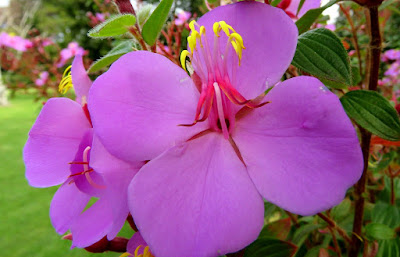Humboldt's single bristle gives bees a leg up
There are more than 50 species of Monochaetum, all of them from the mountains of Mexico and down through to the Andes. This one is Monochaetum humboldtianum, named after Prussian explorer and naturalist, Alexander von Humboldt, whose most famous journey was to Central America in the first years of the nineteenth century. The species grows naturally in the Coastal Range of northern Venezuela.
You'll notice that the leaves and flowers look a lot like Tibouchina, a common blue and sometimes pink flowered tree in Australian gardens (particularly the popular cultivar 'Alstonville', of Tibouchina lepidota, which was bred at Alstonville in northern New South Wales). Tibouchina has a similar distribution through Central and northern South America.
Look again and you might notice there are four petals on this flower (which is more pink than purple in nature) I photographed in our Melbourne Gardens. That's different to Tibouchina, which has five.
Deeper inside the flower it again looks superficially similar to Tibouchina, with two kinds of stamens (the structures that bare pollen in the flower), but in Monochaetum the group of stamens opposite the petals are larger than those opposite the sepals - the reverse is true for Tibouchina. Each of the stamens, big or small, has two arms, one technically an 'appendage'.
In the case of the stamens arising opposite the petals, the appendage looks just like the pollen-bearing (anther). This makes it look like a forked anther of some kind - you can see this in the bottom right of the following picture. The other stamens, the ones opposite the petals, have a long purple appendage reflexed downwards and reaching out to the style.
All this is quite different to the flowers of Tibouchina (which we used to sometimes call Lasiandra), illustrated here from Wikimedia Commons:
There are other genera in the family Melostomataceae with four petals and they don't look wildly different. In fact this particular specimen near the Green Waste Recycling Centre in the Melbourne Gardens isn't on our 'living plant census'. The closest you'll find, in location and taxonomy, is Centradenia grandifolia which is purportedly in a garden bed just around the corner. In fact what I found there seems to be a different genus again, with five petals.
But for arguments sake let's assume there are some Centradenia in the Gardens somewhere. That genus has leaves that are asymmetrical at the base, and different in size overall compared to the leaf opposite it on the stem (i.e. anisophylly; although the smaller leaf is sometimes deciduous when young, making it sometimes look like the leaves are what we call alternate rather than opposite). The stems are also 'winged', with four angular ridges. All unlike our vegetative plant, which looks like this.
I'm happy my plant belongs to Monochaetum humboldtianum. It gives me the chance to mention Alexander von Humboldt, as I've done, and to point out that 'monochaetum' is Greek for 'single bristle', a reference to the purple appendage I mentioned above. Most genera in the family Melostomataceae have this appendage, but this one is named after them! Because they are pollinated by bees, using buzz pollination, it's thought the appendages held the bees get a foot hold.
Charles Darwin was fascinated by the stamens in this family and in addition to growing and crossing plants himself, he sought detailed advice from botanists such as George Bentham. This quote is just the start of a letter that continues with torrent of detailed questions about their floral architecture, bulling Bentham into examining herbarium material on his behalf.







Comments
buy plants online